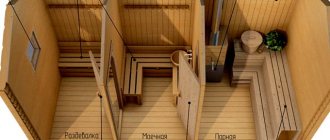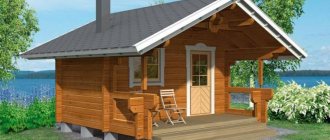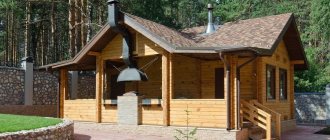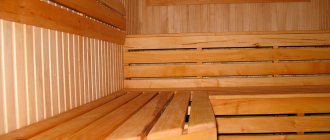Most experts agree that in modern projects of large one-story baths there is a tendency to transform full-size steam rooms and saunas into something more, for example, into a complex for relaxation and entertainment. If free funds and resources allow, why not invest them in the construction of a real large bathhouse project, even a one-story one.
What is a modern large bathhouse?
To organize a full-fledged sauna project, it is not enough to build a large room with a steam room. Sometimes customers specifically build one-story bathhouse buildings with one huge hall. But this is rather an exception to the rule, since such projects are developed for training complexes, and the bathhouse section serves only for relaxation, relieving fatigue and stress.
The design of a large one-story bathhouse includes at least five main rooms:
- The entrance part or hallway, the main function of which is to stop the flow of dust and cold air from the street;
- Restroom;
- Buffet or small pool;
- Bathroom;
- Steam room or hammam with washing compartment.
In former times, the steam of a Turkish bath was considered “weak”, so the oriental bath was not included in old designs of large bathhouses. In practice, it turned out that warm, moist steam with high mineralization is an ideal means for maintaining the immunity of people with chronic diseases. Not everyone can sit in a hot sauna or Russian steam room with a high temperature load on the body, so hammam is included in the designs of almost any large one-story bathhouse.
Advice! If there is not enough space in a one-story bathhouse, then it is quite possible to combine a sauna with a Russian steam room in one room.
To do this, you will need to provide for the installation of an electric steam generator in the project; it can also be used for hammam.
Any large project must have a boiler room or furnace room. The huge amount of heat consumed by the bathhouse forces us to install a steam-water boiler using any type of fuel and a boiler instead of a brick stove. On average, a room of at least 7 m2 is allocated for the boiler room of a large bathhouse, or the equipment is moved to a one-story extension.
How to choose a stove based on the dimensions of the bath
Heating the room to the desired temperature and the quality of the steam produced depend on the power of the furnace. For gas and wood stoves, this factor is not critical, since they already heat the room well. But the wrong choice of power of the electrical appliance will lead to the fact that in the winter it will be cold in the steam room.
The stove is installed in such a way that the heater is in the steam room, and the firebox itself with a reservoir for hot water is in the shower room.
Even a small metal stove will heat a room with a volume of 18 cubic meters. m, will heat up to 70 liters of water.
In small steam rooms it is customary to install metal stoves. They are compact and quickly gain temperature.
To improve the duration of heat transfer, a metal stove is lined with brick.
For a classic Russian bath with a large steam room, a brick oven remains always relevant.
The optimal design of a large one-story bathhouse
Anyone who has had the opportunity to build or look for a ready-made design solution knows that there is simply no such thing as too much space in a bathhouse. If you have the opportunity to build, then the best choice would be a 12 by 12 m bathhouse project. You can, of course, find a two-story project, but despite all the savings in usable space, this option is more expensive in construction.
One of the options for a possible project for a large full-size bathhouse is shown in the diagram below.
Nuances of sauna layout
While a bathhouse often combines a steam room with a shower room to save space, a classic Finnish sauna has three separate rooms:
- steam room;
- shower;
- dressing room
The steam room has no windows and is small in size. The dressing room is made spacious, since people steam in the sauna for 20 minutes with breaks.
A stove with an open firebox is installed in the steam sauna. The stones lie on top in plain sight, but they are not watered. Steam and high temperature are enough.
Dry steam is one of the differences between a bath and a sauna.
Nowadays, wood-burning stoves are increasingly being replaced by electric heaters of the same power. They quickly heat the room and retain heat well.
A characteristic feature of the sauna is the presence of a swimming pool. After spending time in the steam room, vacationers swim in the cold pool. A shower room is installed nearby.
Construction of the log house and foundation
Massive one-story bathhouse buildings measuring more than 9x9 m are characterized by the use of several standard techniques:
- The walls, facade and entrance group are made of rounded logs;
- The roof is in chalet style, with a deep canopy over the entrance and a large terrace;
- According to the project, the foundation of the building is combined. The frame of the house is installed on a concrete strip, and the lighter terraced part of the one-story building is laid on a columnar foundation.
For your information! Adding a terrace to a foundation of a different type than that of the main building carries certain risks for frame and brick structures. In our case, the use of a columnar design has absolutely no effect on the stability and strength of the wooden frame.
Using a similar technology, you can install the largest one-story baths with extensions for a swimming pool or gym. This technique is not used for two-story and attic structures. For a bathhouse 8 by 8 m or less, brick strip foundations are traditionally used; they are much warmer than concrete ones and at the same time easier to manufacture.
Choosing a place to build a bathhouse
It is worth considering some nuances:
- The correct place for a bath should be at some distance from other objects;
- between the bathhouse and the fence of the neighboring area - 1 m or more;
- from any wooden building - from 15 m;
- be away from the garage, wells, swimming pools, children's areas;
- the optimal place to build a bathhouse is the backyard;
- you should decide in advance: the bathhouse is a separate building or an extension to the house;
- when designing, it is necessary to provide for ventilation and wastewater disposal;
- It is necessary to take into account climatic conditions and soil. The surface for construction is chosen to be flat;
- in general, the place must comply with the requirements of regulations and legislation.
Layout of a large bathhouse
In this project, the terrace is used as one of the leading elements of the layout. The huge covered space of 36 m2 can be used as a summer dining room or a place to relax for the whole group.
The excess space in the large bathhouse makes it possible for 10-15 visitors to take bath procedures at the same time. In addition, the almost doubled area of the steam room and washing compartment allows you to install and use the most interesting elements of modern steam rooms and sinks.
For example, in a bathroom with an area of 15.2 m2, the project provides for the installation of a hydromassage and a thermal barrel, in a sufficiently large steam room you can make a compartment for salt breathing, and a Japanese furako will fit in the dressing room.
Parameters of other rooms (locker rooms, dressing room, shower)
When drawing up a plan for a bathhouse, it is important to pay attention to the size of other rooms.
Locker room
The locker room is located at the entrance to the building. In small baths, it also acts as a dressing room. The width is kept to a minimum of 1 to 1.2 m. The length depends on the shape of the building.
Shower room (washing area)
The area of the washing room must be determined, taking into account that 1.5 square meters is used for 1 person. m area.
In a bathhouse for 4 guests, the shower room with a font should be at least 2 * 2.1 m.
Waiting room
A dressing room in a small building (for 3-4 people) can simultaneously perform several functions:
- Act as a relaxation room.
- Serve as a vestibule - a transition between the steam room and the street.
- Used as a fuel storage room, to put a beautiful woodpile, a neat container for coal.
- To be a locker room.
To keep the dressing room bright, it is better to install large windows. Metal-plastic double-glazed windows are well suited. Installation is carried out at a level of 1 m from the floor.
The average size of a dressing room combined with a rest room for 4 people is 1.8 * 3.6 m. A dressing room of 3 * 3 m is considered spacious.
Construction design options
The above project for a large bathhouse does not have a swimming pool. The developers chose the classic Russian style, in which the swimming pond is usually located outside the building. Sometimes customers insist on including a small indoor pool or bathhouse in the design. This bath complex can be easily recognized by its elongated extension with large windows.
Log walls and a carved facade according to the project do not imply the arrangement of large window openings. For those who do not like old Russian decor, you can choose a chalet-style bathhouse design with large window openings.
Full-size baths, with an area of 100 m2 or more, are recognized by experts as the best option when it comes to family or group recreation. Most often they are built without architectural refinements, with large and very sloping roof overhangs. This arrangement ensures minimal load on the walls and good resistance to wind and rain.
For lovers of modern architectural solutions, you can choose a bathhouse project made of foam concrete, which does not have a terrace, but is successfully replaced by a glazed recreation area.
Layout on the site
You need to start by choosing a place to build a bathhouse. In this case, you need to rely on data from a geological survey of the site: choose the best soils and the lowest location of groundwater. Then the foundation can be made inexpensively, and the bathhouse will stand well. Without such a survey of the site, you have to choose at random.
Minimum distances from various objects on the site to the bathhouse
In this case, it is advisable to immediately exclude places where groundwater comes close. They can be seen at sunset. Inspect the area in the evening. If there are places where small midges hover in a column in one place, there is water close below. It’s good to dig a well here, but you can’t build a house or a bathhouse.
Having excluded all wet areas, you can try to fit the planned building in dry areas. There are also some restrictions here:
- the distance to the well should not be less than 5 meters;
- the distance to the nearest residential building is at least 8 meters;
- The toilet and compost pit should be located as far away as possible.
If your site overlooks the shore of a river or lake, it makes sense to put a bathhouse nearby: you can take a dip and not bother with building a pool. It will also be possible to organize a water supply from the reservoir, but in this case it will be necessary to fool around with the drainage so that the wastewater does not get there. So the optimal location of the bathhouse on the site is an individual matter.
If the site overlooks a body of water, it makes sense to place the bathhouse near the shore
A simple bathhouse project 10 by 10 m
The building, with an area of about 100 m2, is rarely used only as a place for bathing procedures and washing. Most often, if the project is correctly drawn up, there is enough free space in the room in order to, in addition to a sink and a steam room, organize a place for a weekend or a home party.
One of these options for a one-story bathhouse is presented below.
How to decide on a project
It won’t be long before you get lost in the variety of bathhouse projects offered, especially when you consider that all of them are described by a relatively small number of characteristics. If we put aside the aesthetic side of the issue for a while (as we know, there is no arguing about tastes), then there will remain several criteria that are of fundamental importance in choosing the final option. Significant characteristics include the following parameters:
- Bath area . Size and spaciousness determine the level of comfort and functionality of the building.
A turnkey bathhouse with shower and toilet - although modest in size, but very comfortable Source pinterest.at
- Construction parameters . This includes design features (number of floors, the presence of an attic or veranda), as well as the type of building material, foundation, and type of roof.
- Layout . Finished projects contain the required premises (locker room, washing room and steam room); the rest may be present in different combinations.
- Design . If you want to ensure a consistent style across all buildings on your property, design can make all the difference.
Design of a universal bath
The building, 10.6x10 m, is built of aerated concrete on a monolithic foundation. Concrete columns are installed in the corners of the box, which take the main load from the roof and ceiling. Thanks to this, it became possible to abandon the middle reinforcing belt and, as a result, make huge windows in a one-story bathhouse.
Such a solution is rarely found in steam room projects, but in this case the windows are equipped for additional lighting of the pool room. The sloping sloping roof goes well with the appearance and design of the building.
The developers abandoned the traditional wooden style by finishing the facade of the bathhouse and the walls of a one-story building with a block house, clapboard or any other material that imitates timber or logs. The main emphasis of the project is on creating a modern, beautiful one-story room, regardless of the purpose and method of its use.
The steam room and swimming pool occupy the left wing of the building, all the stoves and heating appliances are located here, while the washing department has its own separate entrance from the side of the one-story building. On the right, sunny side there is a small terrace and a working entrance to the bathhouse.
Standards for ceiling heights in baths and saunas
Photo: calculation of the height of the shelves in the Finnish sauna and Russian bath
The main criterion for the height of the ceilings in the bathhouse is the maximum height of the guests, therefore the minimum ceiling height is 2.1 m, the optimal (for a comfortable swing of a broom) is 2.5 m.
To steam while sitting, add 1 m to the level of the top shelf. For massage procedures with a broom, you will have to add another half a meter. The level of the top shelf is made higher than the layer of stones on the stove.
In the bathhouse, the ceiling should not be too low (less than 2 m), otherwise the cold air will not displace hot air upward and it will become impossible to breathe in the steam room.
The threshold before entering the steam room is made high, at least 10 cm above the floor level. This way the steam will stay inside the room better and longer.
In a sauna, the approach to determining the optimal height is somewhat different. Here there is a uniform circulation of air flows from bottom to top and there is no need to wave a broom. Vacationers steam in a sitting position.
The height of the ceiling in the sauna is determined by the number of shelves. The main thing is that there is a distance of 1 m from the top shelf to the ceiling.
Layout and design of the project
This project uses a non-standard room layout.
First of all, the idea of distributing usable space in a large one-story building has changed. Instead of proportionally increasing the area of the steam room, washing department, dressing room-restroom, as was the case in the previous bathhouse project, the entire space was divided into two almost equal parts.
Approximately half of the large space was allocated for arrangement:
- Steam rooms 7.5 m2;
- Washing room 6.25 m2;
- Swimming pool - 15 m2;
- Changing rooms – 4.5 m2.
The rest of the territory of the one-story bathhouse was left for the arrangement of a recreation area. This is a kitchen-dining room with an area of 26 m2, and a recreation room with an area of almost 30 m2. For relaxation, you can use the covered terrace of the bathhouse, with an area of 12 m2.
This arrangement of a one-story bathhouse can be called the most universal, since it is ideal for collective recreation with family, team, and the room can also be used for a corporate event.
The disadvantages of this project include the lack of a summer area. Any vacation requires the presence of a gazebo or canopy, under which you can relax at any time of the year.
Lenght and width
When choosing the linear parameters of a steam room, you should proceed from the generally accepted area norm - 1 m2 per person. However, there are some peculiarities here. It is necessary to take into account the type of bath. If for a sauna it is considered quite normal to sit alone in a small steam room, then for a Russian bath it is necessary to provide sufficient area to place a shelf on which an adult can lie down at full height.
Taking this into account, the length of one wall of the steam room should be approximately 1.8 m (preferably 2 m for tall people). Then the width of the room can be 1.1-1.3 m. It is not advisable to do less - being in close proximity to the heater is dangerous - this can lead to burns.
Therefore, the minimum size of the steam room in a Russian bathhouse will in any case be designed for the presence of two people.
For a sauna, the minimum is calculated based on the size of the seat. On the wall with the heater, a room of 1.1-1.2 m is enough for one user. The adjacent wall (with a seat) can be 80-85 cm.
When calculating the area of the steam room, one must proceed from the following conditions:
- take into account the amount of space per person;
- add stove area;
- place the stove so that it is near the entrance (preferably in the corner).
For example, you need to build a steam room for 4 people. They will require a total of 4 m2 of space, plus 1 m2 for the stove. The total area of the steam room should be 5 m2. But that's not all - you need to decide on the configuration of the room.
The best option is a rectangle measuring 2 × 2.5 m. In this case, 2 m walls should be allocated under the entrance and the shelf opposite to it. Shelves should also be placed along longer walls so that 3 people can lie on them at the same time (and one stands with a broom).
If the steam room needs to accommodate more people, you will have to increase the length of one of the walls so that two people can lie on the long shelf. At the same time, it is not recommended to increase the length of the side walls, as this will move the long shelf away from the stove and weaken the heating mode.
Home project of a bathhouse 9x9 m
According to statistics, approximately 40% of baths are extensions to a residential building, another 20% are small-sized steam rooms up to 30 m2, built in the backyard of the local area. The rest falls on the share of separate one-story baths, with an area of 60-80 m2. The popularity of a large bathhouse is determined by the high level of comfort, so the demand for 9 by 9 m bathhouse designs is only increasing.
For your information! The cost of building one square meter for a small-sized steam room is approximately 2.5 times lower than for a one-story bathhouse with an area of 80-100 m2.
It is economically unprofitable to build large bathhouses, even if the project was planned taking into account energy-saving technologies, modern materials for wall insulation, the use of an electric meter with a night tariff and heat recuperators. However, more than 60% of customers choose full-size single-story options.
One of the typical bathhouse designs is presented in the diagram below.
A one-story building made of profiled timber 150x150 mm with additional insulation with a 100 mm layer of ISOVER/KNAUF Ursa. The strip foundation is reinforced at the corners of the bathhouse with pile supports. The facade and walls are lined with siding, but cheaper pine lining can also be used.
The cost of building a one-story turnkey bathhouse is 700 thousand rubles, the construction of a “bare” frame according to the project will cost 500 thousand rubles.
For suburban areas and summer cottages, the project of a summer bathhouse with a gazebo may seem more interesting.
In this case, the sauna box is tied to a disproportionately large covered terrace. The interior of the bathhouse is designed for 4-5 people. The main advantage of such a layout is that the structure made of timber is universal. There is enough free space in the room to equip everything necessary for long-term living on the site.
Questions and answers
Let's look at some of the most common questions that arise during the design of a steam room.
Are there certain standards by which the size of the steam room is determined?
No, such standards do not exist. You can find some instructions in different SNiPs, but they are scattered and cannot be defined as general requirements.
Which wall of the steam room should be longer?
The wall opposite the heater and the entrance should be longer. Even if the room is small, its length should be 1.8 m. This will ensure the most uniform distribution of steam and thermal energy from the heater.
If the size of the steam room is for 5 people, should there be 5 sun loungers?
No, that's not true. You can place 5 sunbeds in the steam room only if the sunbeds are arranged in a compartment format - one above the other. This is impractical and inconvenient. Therefore, they do it simpler - one user lies on the shelves, the other floats him. Then they change places.
If all users are short, what is the optimal room height for them?
Experienced people recommend not raising the ceiling higher than 30 cm above your head. However, even for short people, you shouldn’t make a low room - it’s better to lay plank flooring underneath, which increases the height of the floor.
Is it worth making a steam room for more than 5 people?
A large steam room will accordingly increase the overall size of the bathhouse and will require the installation of a powerful stove with high fuel consumption. If these measures are justified and the number of users will always be large enough, you need to calculate the size and build a steam room of the required size. If there can be a large number of users only occasionally, it is better to get by with a medium size and take turns taking turns.
How to decide on the material
Owners planning to build such a useful place for recreation and health promotion must also decide on the material. Wall material will directly affect the durability of the building and the internal microclimate. The choice is regulated by the rules of SNiP 30-02-97, and since baths are most often heated by wood stoves, these rules are quite strict. To make the bathhouse functional and inexpensive to operate, the following criteria are used when determining the material:
- Compliance with operating conditions . The material must be resistant to temperature fluctuations and high humidity.
Bathhouse in traditional Russian style Source exceltut.com
- Heat saving . The material must provide acceptable thermal insulation of interior spaces without additional costs.
- Extra options . The choice is influenced by the size of the bathhouse, location, and allocated budget.
For centuries, baths were built from wood. A considerable part of modern solutions offered by construction organizations are also made from this unique natural material. Many, not without reason, believe that the best bathhouse designs should be made only of wood; The reasons are hidden in the following advantages:
- Cost-effectiveness during construction . Wood is one of the most affordable materials; and construction work is characterized by tight deadlines and simplicity.
- Physical properties of wood . Bath walls made of high-quality building materials are durable, have good thermal insulation and natural ventilation.
- Environmental friendliness . A wooden building boasts improved steam quality and a healthy microclimate, which has a positive effect on health.
The design of a corner bathhouse made of wood - no one doubts its environmental friendliness Source srubytveri.ru
The disadvantages of wood are its natural shrinkage (due to which you have to take a break in construction for 5-6 months), fire hazard and the need for periodic maintenance of wooden walls. On construction sites you can see baths made of the following wooden building materials:
- From timber . Glued laminated or profiled timber, a modern industrially produced material, has many advantages. Bathhouses made of timber are assembled quickly and efficiently, demonstrate good thermal insulation properties and are cheaper than buildings made of rounded logs. The material is suitable for implementing projects of any complexity. Edged timber usually does not go through the drying process and can become deformed, which will cause additional costs for insulating the roof joints.
- From a log . The log sauna has an aesthetic appearance and is designed for long-term use due to the preserved structure of the wood. Both chopped and rounded logs are characterized by simple installation, which is complicated only by the large weight of the logs. Such buildings heat up quickly and cool down slowly, providing additional comfort.
Log baths are famous for their durability Source remontreal.ru
- Frame structures . Frame baths, in which natural wood is combined with other materials, are becoming an increasingly common choice. Frame structures are erected quickly and do not require an expensive foundation.
- Made of brick . Red brick is an environmentally friendly material that is used for the construction of walls, foundations, stoves and chimneys. Brick baths are distinguished by their aesthetic appearance, they are durable and fireproof, but have a high heat capacity, which affects the heating time of the premises. Additional thermal insulation increases the cost of the project, but in general a brick bathhouse is more affordable than a log bathhouse.
- From blocks . In recent years, cinder blocks, as well as blocks made of gas and foam concrete, have begun to be actively used for the construction of baths. The materials have different technical characteristics, but all are lightweight and allow for lightweight and budget-friendly construction. A bathhouse made of blocks requires reliable steam and waterproofing, as well as external and internal finishing.
Bathhouse made of blocks with a wooden facade Source stroi-ideya.ru
Sketch of a budget bath
Before you start building a bathhouse, you need to decide on its design. It is enough to draw on a piece of paper what will be located and where approximately.
You need to understand the location of the sewer system, how water will flow, how electrical wires will be installed, and so on.
How to decide on a layout
The bathhouse design should be as detailed as possible. This will give the customer the opportunity to receive a detailed estimate, determine the budget and control the construction. When choosing a bathhouse, designs with dimensions allow you to study the internal layout in detail, eliminating unsuitable options. A detailed layout of a finished (standard) bathhouse is useful in solving the following issues:
- Comfort rating . The customer can appreciate the thoughtfulness of the construction, especially the convenience of the relative position of the rooms and the stove.
- Selection and purchase of building materials . Precise drawing dimensions allow you to spend less time and save money.
- Laying utility lines . Proper water supply, electrical wiring and ventilation will be provided; No expensive rework will be required in the future.
- Purchasing furniture . Even before construction begins, you can select furniture that is suitable in size.
Video description
What to look for when choosing a material for a bath, see the following video:
Modern baths are complemented by various elements that increase functionality and comfort; The following solutions are considered the most popular:
- Second floor . A full second or attic floor is a useful detail of the project. The usable area thus increased can be used in a variety of ways: to organize a spacious recreation room, a billiard room, a gym or a guest room for friends staying over the weekend.
- Additional details . The porch, loggia, balcony and terrace serve as an excellent decorative element and compensate for the small size of the interior spaces. A relaxation area with a barbecue is often designed on the terrace, and a glazed and insulated veranda will allow you to relax comfortably in any weather.
- Swimming pool and/or sauna . In order for the project of such a bath complex to become a reality, a lot of effort will have to be made. Such a complex will occupy a large area, and a separate foundation will be required for the pool.
Ready-made small bathhouse for a summer house using frame technology with a terrace Source stroyider-nn.ru
Cost of turnkey projects
In many cases, simultaneous ordering of a bathhouse project with turnkey construction is the preferred option for the customer. This service allows the future owner to entrust all issues related to construction to the specialists of the construction organization, ultimately receiving a building ready for use. The cost of a turnkey project is influenced by several factors:
- Choice of material.
- Project type. The cost of the finished project is extremely affordable and depends on the payback (the number of previous sales).
- The need for individual changes.
- Structural complexity and area. The simpler the building geometry, the smaller the construction budget will be.











